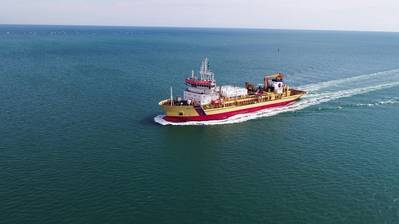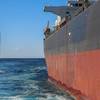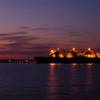First European Dual-Fuel Dredger Conversion
Damen Shiprepair & Conversion has signed off on the conversion of a dredger to dual-fuel operation on liquefied natural gas (LNG) and marine gas oil (MGO), and which is powered by MAN 35/44DF engines.
The conversion of the ‘Samuel de Champlain’ is the first of its kind in Europe and is part of an EU-supported initiative to promote LNG propulsion in short-sea vessels operating along the European Atlantic coast.
The 117m, 8,500m³ trailing suction hopper dredger is owned by Rouen-based GIE Dragages-Ports and operated by Port of Nantes-Saint-Nazaire. Its conversion involved the replacement of its diesel-electric MGO-burning propulsion system with 3 × MAN 6L35/44DF dual-fuel models, as well as the installation of onboard LNG storage facilities.
The Samuel de Champlain was built in 2002 and is the largest in the GIE Dragages-Ports fleet. Based in the Port of Nantes-Saint-Nazaire, the vessel operates between the Loire and Seine estuaries.
The MAN 35/44DF engine
Damen and Dragages-Ports selected an MAN 35/44DF propulsion solution on account of its outstanding performance criteria and increased environmental friendliness. Decisive criteria for a 35/44DF solution include:
- outstanding load-step capability that can handle the high load-fluctuations that are typical for dredger applications
- ability to dredge continuously in gas-mode operation (Tier III) without switching over to diesel-mode (Tier II)
- pure gas-start capability for minimal NOx emissions from start of operation
- gas-mode operation from 0 - 110% load, with no need to switch over to diesel operation upon reaching 100% load – in other words, continuous Tier III operation with minimal NOx emissions
- automated adaptive combustion control in the event of changing ambient conditions, gas quality, wear and tear, etc. with the ability to maintain gas operation at the highest efficiency over time
- the ability to operate even with poor gas-quality, down to a methane number of 70MN, without derating the engine power output, enabling operation on a wider variety of fuels with different qualities and expense.
Project background
The conversion project was granted by the European Commission’s Innovation and Networks Executive Agency (INEA) via its Connecting Europe Facility program. To qualify for funding, GIE Dragages-Ports formed a consortium to promote the use of LNG by small-scale vessels on the Atlantic coasts of Spain and France and up into the English Channel – in the process, kickstarting the development of an LNG bunkering network.
The conversion of the Samuel de Champlain intends to demonstrate the feasibility of using LNG as a fuel on smaller vessels, and allows GIE Dragages-Ports to optimize costs by reducing fuel bills and engine maintenance, while simultaneously reducing CO2, NOx and particulate matter emissions.














